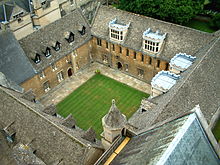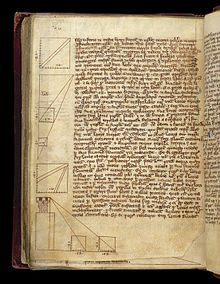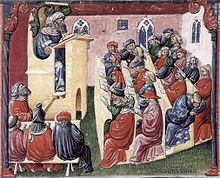- Medieval university
-
This article is about Western European institutions. For unrelated ancient centers of higher learning, see ancient higher-learning institutions. For an overview of medieval foundations, see List of medieval universities.
Medieval university is an institution of higher learning which was established during High Middle Ages period and is a corporation.
The first institutions generally considered to be universities were established in Italy, France, and England in the late 11th and the 12th centuries for the study of arts, law, medicine, and theology.[1] These universities evolved from much older Christian cathedral schools and monastic schools, and it is difficult to define the date at which they became true universities, although the lists of studia generalia for higher education in Europe held by the Vatican are a useful guide.
"The word universitas originally applied only to the scholastic guild (or guilds)—that is, the corporation of students and masters—within the studium, and it was always modified, as universitas magistrorum, or universitas scholarium, or universitas magistrorum et scholarium. In the course of time, however, probably toward the latter part of the 14th century, the term began to be used by itself, with the exclusive meaning of a self-regulating community of teachers and scholars whose corporate existence had been recognized and sanctioned by civil or ecclesiastical authority."[2]
From the early modern period onwards, this Western-style organizational form gradually spread from the medieval Latin west across the globe, eventually replacing all other higher-learning institutions and becoming the preeminent model for higher education everywhere.[3]
Contents
History
Beginnings
The university is generally regarded as an institution that has its origin in the Medieval Christian setting.[4][5] Prior to their formal establishment, many medieval universities were run for hundreds of years as Christian cathedral schools or monastic schools (Scholae monasticae), in which monks and nuns taught classes; evidence of these immediate forerunners of the later university at many places dates back to the 6th century AD.[6]
With the increasing growth and urbanization of European society during the 12th and 13th centuries, a demand grew for professional clergy. Before the 12th century, the intellectual life of Western Europe had been largely relegated to monasteries, which were mostly concerned with the performing the liturgy and prayer; relatively few monasteries could boast true intellectuals. Following the Gregorian Reform's emphasis on canon law and the study of the sacraments, bishops formed cathedral schools to train the clergy in Canon law, but also in the more secular aspects of religious administration, including logic and disputation for use in preaching and theological discussion, and accounting to more effectively control finances. Learning became essential to advancing in the ecclesiastical hierarchy, and teachers also gained prestige. However, demand quickly outstripped the capacity of cathedral schools, each of which was essentially run by one teacher. In addition, tensions rose between the students of cathedral schools and burghers in smaller towns. As a result cathedral schools migrated to large cities, like Paris and Bologna.
The first universities (University of Bologna (1088), University of Paris (teach. mid-11th century, recogn. 1150), University of Oxford (teach. 1096, recogn. 1167), University of Modena (1175), University of Palencia (1208), University of Cambridge (1209), University of Salamanca (1218), University of Montpellier (1220), University of Padua (1222), University of Toulouse (1229), University of Orleans (1235), University of Siena (1240) and University of Coimbra (1288)) began as private corporations of teachers and their pupils. Soon they realized they need protection against local city authorities. They petitioned secular power for privileges and this became a model. Emperor Frederick I in Authentica Habita (1158) gave the first privileges to students in Bologna. Another step was when Pope Alexander III in 1179 "forbidding masters of the church schools to take fees for granting the license to teach (licentia docendi), and obliging them to give license to properly qualified teachers".[7]
Some scholars such as S. F. Elatus and George Makdisi have noted some parallels between Madrasahs and early European colleges and have thus inferred that the first universities in Europe were influenced by the Madrasahs in Islamic Spain and the Emirate of Sicily.[8][9] Other scholars such as George Makdisi,[10] Toby Huff or Norman Daniel, however, have questioned this, citing the lack of evidence for an actual transmission and highlighting the differences in the structure, methodologies, procedures, curricula and legal status of the "Islamic college" (madrasa) versus the European university.[11][12] Yet other scholars such as George Makdisi strongly disagree with the above theory and propose that the paradigm of a university as a center for cross-discipline scholarship developed in medieval Europe and came to influence the evolution of madrasas in the latter part of the millennium.[13]
Establishment
 Teaching at Paris, in a late 14th-century Grandes Chroniques de France: the tonsured students sit on the floor
Teaching at Paris, in a late 14th-century Grandes Chroniques de France: the tonsured students sit on the floor
A predecessor of the modern university was in Paris, especially under the guidance of Peter Abelard, who wrote Sic et Non ("Yes and No"), which collected texts for university study. Dissatisfied with tensions between burghers and students and the censorship of leading intellectuals by the Church, Abelard and others formed the Universitas, modelled on the mediaeval guild, as a self-regulating, permanent institution of higher education. The University of Paris became one of the first clearly established universities, when Pope Gregory IX issued the bull Parens scientiarum (1231).[7]
This was a revolutionary step: studium generale (university) and universitas (corporation of students or teachers) existed even before, but after the issuing of the bull, they attained autonomy. "[T]he papal bull of 1233, which stipulated that anyone admitted to be a teacher in Toulouse had the right to teach everywhere without further examinations (ius ubique docendi), in time, transformed this privilege into the single most important defining characteristic of the university and made it the symbol of its institutional autonomy . . . By the year 1292, even the two oldest universities, Bologna and Paris, felt the need to seek similar bulls from Pope Nicholas IV."[7]
 Mob Quad, in Merton College, Oxford. This group of buildings was constructed in three phases and concluded in c. 1315.
Mob Quad, in Merton College, Oxford. This group of buildings was constructed in three phases and concluded in c. 1315.
By the 13th century, almost half of the highest offices in the Church were occupied by degreed masters (abbots, archbishops, cardinals), and over one-third of the second-highest offices were occupied by masters. In addition, some of the greatest theologians of the High Middle Ages, Thomas Aquinas and Robert Grosseteste, were products of the medieval university.
The development of the medieval university coincided with the widespread reintroduction of Aristotle from Byzantine and Arab scholars. In fact, the European university put Aristotelian and other natural science texts at the center of its curriculum,[14] with the result that the "medieval university laid far greater emphasis on science than does its modern counterpart and descendent."[15]
Although has been assumed that the universities went into decline during the Renaissance because the scholastic and Aristotelian emphasis of its curriculum was less popular than the cultural studies of Renaissance humanism, Toby Huff has noted the continued importance of the European universities, with their focus on Aristotle and other scientific and philosophical texts, into the early modern period, arguing that they played a crucial role in the Scientific Revolution of the 16th and 17th centuries. As he puts it "Copernicus, Galileo, Tycho Brahe, Kepler, and Newton were all extraordinary products of the apparently procrustean and allegedly Scholastic universities of Europe....sociological and historical accounts of the role of the university as an institutional locus for science and as an incubator of scientific thought and arguments have been vastly understated."[16]
Characteristics
 Diagrams, in a volume of treatises on natural science, philosophy, and mathematics. This 1300 manuscript is typical of the sort of book owned by medieval university students.
Diagrams, in a volume of treatises on natural science, philosophy, and mathematics. This 1300 manuscript is typical of the sort of book owned by medieval university students.
Initially medieval universities did not have a campus. Classes were taught wherever space was available, such as churches and homes. A university was not a physical space but a collection of individuals banded together as an universitas. Soon, however, some universities (such as Cambridge) began to buy or rent rooms specifically for the purposes of teaching.
Universities were generally structured along three types, depending on who paid the teachers. The first type was in Bologna, where students hired and paid for the teachers. The second type was in Paris, where teachers were paid by the church. Oxford and Cambridge were predominantly supported by the crown and the state, a fact which helped them survive the Dissolution of the Monasteries in 1538 and the subsequent removal of all the principal Catholic institutions in England. These structural differences created other characteristics. At the Bologna university the students ran everything—a fact that often put teachers under great pressure and disadvantage. In Paris, teachers ran the school; thus Paris became the premiere spot for teachers from all over Europe. Also, in Paris the main subject matter was theology, so control of the qualifications awarded was in the hands of an external authority - the Chancellor of the diocese. In Bologna, where students chose more secular studies, the main subject was law.
University studies took six years for a Bachelor's degree and up to twelve additional years for a master's degree and doctorate. The first six years were organized by the faculty of arts, where the seven liberal arts were taught: arithmetic, geometry, astronomy, music theory, grammar, logic, and rhetoric. The primary emphasis was on logic.
Once a Bachelor of Arts degree had been conferred, the student could leave the university or pursue further studies, in one of the three other faculties – law, medicine, or theology – in which to pursue the master's degree and doctorate degree. Theology was the most prestigious area of study, and the most difficult.
Courses were offered according to books, not by subject or theme. For example a course might be on a book by Aristotle, or a book from the Bible. Courses were not elective: the course offerings were set, and everyone had to take the same courses. There were, however, occasional choices as to which teacher to use.
Students entered the University at fourteen to fifteen years of age. Classes usually started at 5:00 or 6:00 AM. Students were afforded the legal protection of the clergy. In this way no one was allowed to physically harm them; they could only be tried for crimes in a church court, and were thus immune from any corporal punishment. This gave students free rein in urban environments to break secular laws with impunity, a fact which produced many abuses: theft, rape and murder were not uncommon among students who did not face serious consequences. This led to uneasy tensions with secular authorities. Students would sometimes "strike" by leaving a city and not returning for years. This happened at the University of Paris strike of 1229 after a riot (started by the students) left a number of students dead; the University went on strike and they did not return for two years. As the students had the legal status of clerics which, according to the Canon Law, could not be held by women, women were not admitted into universities.
A popular textbook for university study was called the Sentences (Quattuor libri sententiarum) of Peter Lombard; theology students and masters were required to write extensive commentaries on this text as part of their curriculum. Much of medieval thought in philosophy and theology can be found in scholastic textual commentary because scholasticism was such a popular method of teaching.
Most universities of international excellence in Europe were registered by the Holy Roman Empire as a Studium Generale. Members of these institutions were encouraged to disseminate their knowledge across Europe, often giving lecture courses at a different Studium Generale.
See also
- List of medieval universities
- Renaissance of the 12th century
- Studium Generale
- Ancient universities of Scotland
- Town and gown
- Nation (university corporation)
Notes
- ^ de Ridder-Symoens 1992, pp. 47–55
- ^ Encyclopaedia Britannica: History of Education. The development of the universities.
- ^ Rüegg, Walter (ed.): Geschichte der Universität in Europa, 3 vols., C.H. Beck, München 1993, ISBN 3-406-36956-1
- ^ Rüegg, Walter: "Foreword. The University as a European Institution", in: A History of the University in Europe. Vol. 1: Universities in the Middle Ages, Cambridge University Press, 1992, ISBN 0-521-36105-2, pp. XIX–XX
- ^ Verger 1999
- ^ Riché, Pierre (1978): "Education and Culture in the Barbarian West: From the Sixth through the Eighth Century", Columbia: University of South Carolina Press, ISBN 0-87249-376-8, pp. 126-7, 282-98
- ^ a b c Kemal Gürüz, Quality Assurance in a Globalized Higher Education Environment: An Historical Perspective, Istanbul, 2007, p. 5
- ^ Alatas, S. F. (2006), "From Jami`ah to University: Multiculturalism and Christian–Muslim Dialogue", Current Sociology 54 (1): 112–132 [123–4], doi:-
- ^ Makdisi, George (April–June 1989), "Scholasticism and Humanism in Classical Islam and the Christian West", Journal of the American Oriental Society 109 (2): 175–182 [175–77], doi:10.2307/604423, JSTOR 604423
- ^ George Makdisi: "Madrasa and University in the Middle Ages", in: Studia Islamica, Vol. 32 (1970), S. 255-264 (264):
Thus the university, as a form of social organization, was peculiar to medieval Europe. Later, it was exported to all parts of the world, including the Muslim East; and it has remained with us down to the present day. But back in the middle ages, outside of Europe, there was nothing anything quite like it anywhere.
- ^ The scholarship on these differences is summarized in Toby Huff, Rise of early modern science, 2nd ed. p. 149-159; p. 179-189.
- ^ Norman Daniel: Review of "The Rise of Colleges. Institutions of Learning in Islam and the West by George Makdisi", Journal of the American Oriental Society, Vol. 104, No. 3 (Jul. - Sep., 1984), pp. 586-588 (587)
- ^ George Makdisi: "Madrasa and University in the Middle Ages", in: Studia Islamica, Vol. 32 (1970), S. 255-264 (264)
- ^ Toby Huff, Rise of early modern science 2nd ed. p. 180-181
- ^ Edward Grant, "Science in the Medieval University", in James M. Kittleson and Pamela J. Transue, ed., Rebirth, Reform and Resilience: Universities in Transition, 1300-1700, Columbus: Ohio State University Press, 1984, p. 68
- ^ Toby Huff, Rise of Early Modern science, 2nd ed., p. 344.
References
- Cobban, Alan B. English University Life in the Middle Ages Columbus: Ohio State University Press, 1999. ISBN 0-8142-0826-6
- de Ridder-Symoens, Hilde: A History of the University in Europe: Volume 1, Universities in the Middle Ages, Cambridge University Press, 1992, ISBN 0-521-36105-2
- Ferruolo, Stephen: The Origins of the University: The Schools of Paris and their Critics, 1100-1215 Stanford: Stanford University Press, 1998. ISBN 0-8047-1266-2
- Haskins, Charles Homer:. The Rise of Universities. Ithaca, New York: Cornell University Press, 1972. ISBN 0-87968-379-1
- Rashdall, Hastings, rev. by F. M. Powicke, and A. B. Emden: The Universities of Europe in the Middle Ages, 3 vols. Oxford: Clarendon Press, 1895; 1987, ISBN 0-19-821431-6
- Rait, Robert S.: Life in the Medieval University, Cambridge University Press, 1931, ISBN 0-527-73650-3
- Seybolt, Robert Francis, trans.: The Manuale Scholarium: An Original Account of Life in the Mediaeval University, Cambridge: Harvard University Press, 1921
- Thorndike, Lynn, trans. and ed.: University Records and Life in the Middle Ages, New York: Columbia University Press, 1975, ISBN 0-393-09216-X
- Verger, J. (1999), "Universität", Lexikon des Mittelalters, 8, Stuttgart: J.B. Metzler
External links
- The Shift of Medical Education into the Universities
- The Educational Legacy of Mediaeval and Renaissance Traditions.
- From Manuscript to Print: Evolution of the Mediaeval Book.
- Life of the Students at Paris.
- Mediaeval History: A Mediaeval Atlas
- Cambridge, A Brief History: The Mediaeval University.
- Mediaeval Science, the Church, and Universities
- Quality Assurance In A Globalized Higher Education Environment: An Historical Perspective (DOC file)
- The Rise of Universities (classic), Charles Homer Haskins, 1923
European Middle Ages Early Middle Ages Migration Period · Decline of the Western Roman Empire · Late Antiquity · Decline of Hellenistic religion · Christianization · Rise of Islam · First Bulgarian Empire · Frankish Empire · Bagratid Kingdom of Armenia · Kingdom of Croatia · Anglo-Saxon England · Viking Age · Carolingian Empire · Old Church Slavonic · Kievan Rus' · Growth of the Eastern Roman EmpireHigh Middle Ages Holy Roman Empire · Armenian Kingdom of Cilicia · Second Bulgarian Empire · Feudalism · Great Schism · Investiture controversy · Crusades · Scholasticism · Monasticism · Communalism · Manorialism · Medieval Warm PeriodLate Middle Ages Culture Architecture · Art · Church and State · Cuisine · Demography · Literature · Medicine · Music · Philosophy · Poetry · Science · Technology · WarfareSee also Categories:- History of education
- Academia
- School types
- Medieval organizations
Wikimedia Foundation. 2010.



